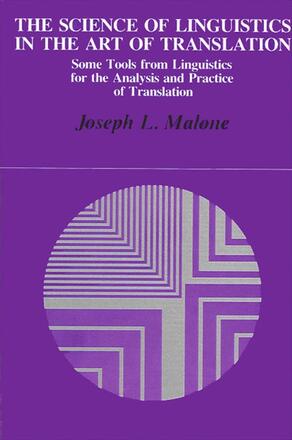Acknowledgements
Introduction
0.1
Basic Goals of the Book
0.1.1 Linguistics and Translation
0.1.2 The Science of Linguistics
0.1.3 The Art of Translation
0.1.4 The Analysis and Practice of Translation
0.2
Linguistic Scaffolding
0.2.1 Primary Organizational Components
0.2.2 Secondary Organizational Components
0.2.3 An Extended Illustration
0.2.4 Compositional Levels
0.2.5 Representational Strata
0.3
Format of Translational Examples and Bibliographical References
0.3.1 Translational Examples
0.3.2 Bibliographical References
0.4
Overview of the Book's Structure
0.5
List of Terms and Symbols Not Defined Elsewhere
0.6
A Note on Terminology
Notes
Part One
Chapter 1
Trajections; Matching (Equation and Substitution)
1.1 Trajections in General
1.1.1 Basic Characterization
1.1.2 Preliminary Examples
1.2 Equation
1.3 Substitution
1.4 Matching
1.4.1 Carry-over Matching
1.4.2 Calque Matching, Prefab Matching, and False Friendship
Notes
Chapter 2
Zigzagging (Divergence and Convergence)
2.1 Divergence
2.1.1 Linguistic Cues
2.1.2 Situational Cues
2.1.3 Stylistic Cues
2.1.4 Artistic Suspense; Stylistically Induced Divergence
2.2 Convergence
2.3 Zigzagging
Notes
Chapter 3
Recrescence (Amplification and Reduction)
3.1 Amplification
3.1.1 Compensatory AmplificationGlossing
3.1.2 Classificatory Amplification
3.2 Reduction
3.2.1 Compensatory Reduction
3.2.2 Variational Reduction
3.3 Recrescence
3.3.1 Minimax Size Adjustments for Metrical Fit
3.3.2 Global Preferences for Larger or Smaller Units
3.3.3 Japanese kureru-yaru and Author's Empathy
Notes
Chapter 4
Repackaging (Diffusion and Condensation)
4.1 Diffusion
4.1.1 Diffusion versus Amplification
4.1.2 Definitional Diffusion
4.1.3 Diffusion of Grammatical Inflections
4.1.4 Diffusion of Sentences
4.2 Condensation
4.2.1 Condensation in Response to Poetic Requirements
4.2.2 Condensation to Compensate for Syntactic Deficiency
4.3 Repackaging
4.3.1 Size Adjustments and Preferences
4.3.2 Repackaging and Recurrence Chains
4.3.3 Repackaging and de novo Translation
Notes
Chapter 5
Reordering
5.0 Preliminaries
5.1 Reordering to Optimize Comprehension
5.2 Reordering Relative to Narrative Flow
5.3 Reordering of Target-Alien Stylistic Patterns (Greek hysteron-proteron)
5.4 Feature Reordering
Notes
Chapter 6
Some Dimensions of Trajectional Analysis
6.0 Preliminaries
6.1 Levels of Composition: Recoding
6.2 Relations Between Trajections
6.2.1 Implications
6.2.2 Hook-ups
6.3 Trajections as Applied-Linguistic Constructs
Notes
Chapter 7
Some Trajectional Parameters
7.0 Preliminaries
7.1 Structural-Strategical Parameters
7.2 Linguistic-Stylistic-Situational Parameters
7.2.1 The Chiaroscuro Nature of Stylistic Patterns
7.3 Compensatory-Classificatory Parameters
7.4 Paradigmatic-Syntagmatic Parameters
7.5 Positive and Negative Hook-ups
7.6 Translinguistic-Unilinguistic Parameters
Notes
Part Two
Chapter 8
Systemic and Formalistic Techniques
8.0 Preliminaries
8.1 The Systemic Perspective: Sets and Scatters
8.2 Charts and Diagrams: Set-to-Set Substitution, Set-to-Scatter Equation
8.3 Japanese Self-Referent Pronouns; French Dizaines versus English Dozens; Scatter-to-Set
Translation
8.4 Formal and Functional Sets
Notes
Chapter 9
Taxonomies
9.0 Preliminaries
9.1 Taxonomic Conflation
9.2 Matching and Diffusional Deconflation
9.3 Nonce Conflation
Notes
Chapter 10
Zeroes
10.0 Preliminaries
10.1 Zeroes in Recurrence and Coreference Chains; Biblical Hebrew Parallelism
10.2 Zeroes in the Study of Style and Textual Ambiguity
Notes
Chapter 11
Abstract Syntactic Representations
11.0 Preliminaries: The Notion of 'Government'
11.1 The Latin Accusative-with-Infinitive Construction
11.2 Some Guidelines for Synthesizing Abstract Syntactic Representations (ASRs)
11.3 Derivations, Rules, and Strata of Representation
Notes
Chapter 12
Bridge Technique
12.0 Preliminaries
12.1 Basic Properties of the Technique
12.2 Spanning: French tâcher and Spanish procurar versus English try
12.3 Refashioning; Antispanning, Lexicalization
12.4 Situational and Stylistic Patterns
12.4.1 Spanish versus English Gender
12.4.2 Hebrew versus English Subject Raising
12.4.3 Norwegian Word Order versus English Extraposition
12.5 Disassembly and Reassembly: Representational Strata and Trajections
Notes
Part Three
Chapter 13
Phonetics, Phonology, and Poetic Form
13.0 Preliminaries: Phonetic Transcription
13.1 Cenematics and Orthometrics
13.2 Feature and Subsequence Rhyme
13.3 Two Modes of Linguistic Application
13.4 Cenematic Strata and Derivations; APRs
Notes
Chapter 14
Transduction
14.1 Turkish Rhyme
14.2 Alliteration in Old Irish
14.3 Transduction
14.3.1 'Ahi Ali Baba'
14.3.2 'Slieve Cua'
Notes
Chapter 15
Transjacence
15.0 Preliminaries
15.1 Paronomasia and Other Cenematic-Plerematic Complexes
15.1.1 Alliterative and Rhyming Binomials
15.1.2 Mimesis
15.1.3 Free Association
15.1.4 Eponymy
15.2 Source-Text Recurrence Chains
15.2.1 Symbolism
15.2.2 Situational Inducement
15.2.3 Patterned or Arbitrary Distribution
15.2.4 The Distance Factor
15.2.5 Author's Proclivity
Notes
Chapter 16
Parallax
16.0 Preliminaries
16.1 Displacement Parallax
16.2 Antipodal Parallax
16.3 Macroscopic Parallax
16.4 Microscopic Parallax
16.5 Personalizing Parallax
16.6 Depersonalizing Parallax
16.7 The Functions of Parallax in Literary Language
Notes
Bibliography
Index of Persons and Translational Resources
Index of Languages
Index of Subjects
